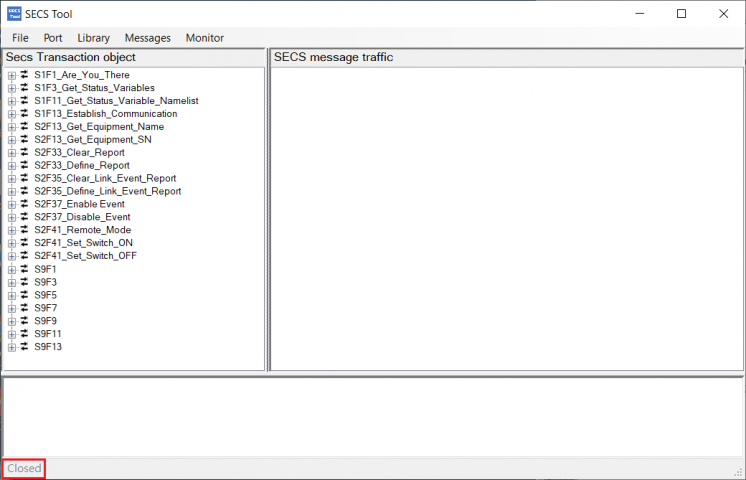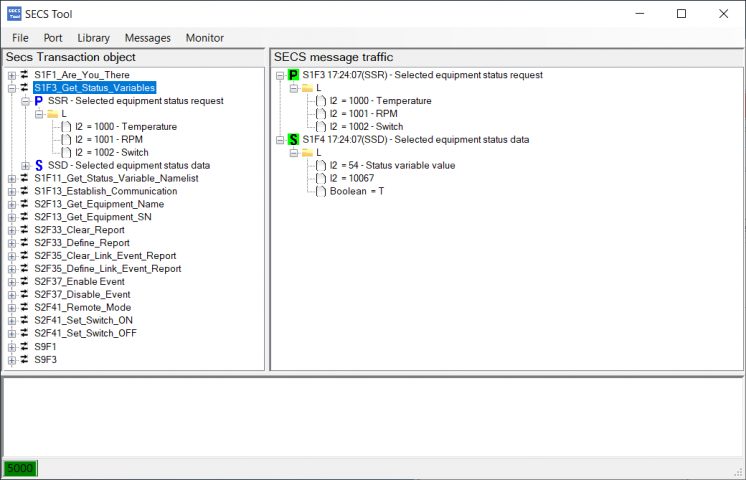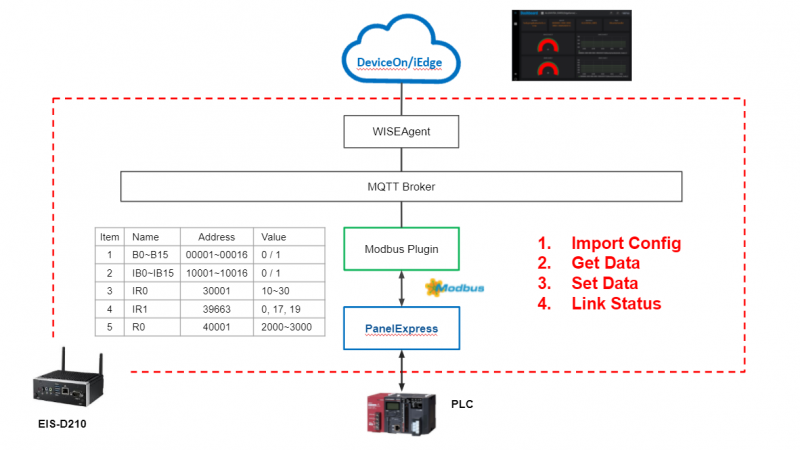IEdge/SRP
iEdge/SEMI
Introduction
iEdgeSEMI is an SRP based on the SECS communication protocol used by semiconductor factories. It includes a built-in SECS library, which helps semiconductor factories integrate process equipment and monitor production status using the SECS protocol. This user manual provides basic information on the functions of the SECS gateway in iEdgeSEMI and common SECS command operations through the interaction of S/F messages between SECS Tool and SECS Gateway.
Content and Important Items
Important Items
The SECS library built into iEdgeSEMI is provided by Giantec Technology. The examples provided in this document are for reference only and do not include any actual process/monitoring equipment data integration services. If there is a need for process/monitoring equipment data integration, please contact Advantech's sales window.
Hardware and Software Information (Table 1)
| Items | Description | Version |
|---|---|---|
| HW | EI-52, RAM: 8GB | |
| BIOS | F1.10 | |
| OS | Windows 10 x64 | Windows 10 Enterprise LTSC 1809 |
| SECS Gateway | The main program of the SECS Gateway | v2.0.0.2 |
| SECS Tool | A demonstration program for a SECS Host | v1.0.0.0 |
| SECS WebUI | The web-based operation interface of the SECS Gateway | v1.0.0.4 |
| Simulator Connector | A SECS Gateway sensor data simulator | v1.0.0 |
Quick Guide
iEdgeSEMI v1.0 is pre-installed on the EID-D210 hardware provided by Advantech for PLC SRP.
Establish a SECS connection
After Windows starts up, SECS Gateway will be automatically launch. please follow below steps to config:
- Step 1. Start the SECS Tool Double-click SECS_Tool.exe under C:\SECS_Gateway\SECSTool to start the SECS Tool.
- Step 2. Set up the SECS Tool connection Click on Properties in the Port function in the upper toolbar.
Enter 1 in the DefaultDeviceID field on the General page.
Select the Active mode in the ConnectionMode on the HSMS page, and enter the IP address of the SECS Gateway in the IPAddressRemort field.
- Step 3. Open the SML file Click "Open SML file…" in the File function.
Select the sample_simulator.sml file under C:\SECS_Gateway\SECSTool.
After the file is loaded, you can see that the SECS commands and messages required by the Simulator have been pre-loaded in the left Secs Transaction Object function menu.
- Step 4. Establishing a Connection Double-click the "Close" button displayed in the lower-left corner of the program to begin the SECS connection.
Once the connection is established, the SECS message traffic area on the right-hand side will display information regarding the connection.
Obtaining Sensor Data
- Step 1. Selecting the Sensor Message to Read Select "S1F3_Get_Status_Variables" from the Secs Transaction Object function menu on the left-hand side. This S/F can be used to read data for temperature, RPM, and switches.
- Step 2. Sending the Message Press Ctrl+s on the keyboard to send the message. The Sensor data will be displayed in the SECS message traffic area on the right-hand side.
Remote SECS WebUI Data Viewing
- Step 1. Remote login to SECS WebUI On another PC, open a web browser and enter the SECS Gateway IP:8090 to open SECS WebUI. The default login credentials are: Username: gsadmin Password: gsadmin
- Step 2. Click "Add Chart"
- Step 3. Enter the following information to create a dashboard
- Step 4. Click "Create" After creating it, you can see the changes in the temperature data.
iEdge/PLC
Introduction
iEdgePLC is an SRP based on PLC communication protocol used in factory automation. iEdgePLC includes over 500 PLC drivers, which can help maintenance personnel of automated factories monitor equipment status. This user manual demonstrates how to use the built-in PanelExpress software to obtain data from a PLC simulator and transmit the data to the iEdge Server, and how users can quickly view the current PLC data on the iEdge Portal.
Content and Important Notes
Important Notes The PanelExpress and PM Designer software built into iEdgePLC are provided by Advantech. The examples provided in this document are for reference only and do not include any actual factory equipment data monitoring and integration services. If there is a need for factory equipment data monitoring and integration, please contact Advantech's sales department.
Hardware and Software Information (Table 1)
| Items | Description | Version |
|---|---|---|
| HW | EIS-D210, RAM: 4GB | |
| BIOS | F1.10 | |
| OS | Windows 10 x64 | Windows 10 Enterprise LTSC 1809 |
| WISEAgent | Make connection with iEdge Server | v1.4.17.1 |
| iEdge Server | Cloud side device Management | v1.2.1 |
| iEdge | Protocol gateway, read PLC data from PanelExpress and upload PLC data to the iEdge Server | v1.2.1 |
| Cermate PanelExpress | PLC drivers and PLC Gateway | v2.1.10.3 |
Quick Guide
iEdgePLC v1.0 is pre-installed on the EID-D210 hardware provided by Advantech for PLC SRP.
Download Project Files
Please download the PM Designer project file and the plc_simulator file from the following links:
- PM Designer project: \\172.22.15.162\ESS-Release\EdgeSense\Release\Windows\iEdgePLC\PLC-Simulator.zip
- PLC Simulator: https://www.win-tech.com/html/modsim32.htm
- PLC Simulator config files: \\172.22.15.162\ESS-Release\EdgeSense\Release\Windows\iEdgePLC\modsim32_plc_simulator.zip
Generate configuration files for PanelExpress and Modbus-Master
- Step 1. Install PM Designer Open the PM_Designer folder on the desktop.
Double-click on Setup_21100300.exe in the PM_Designer folder to install. Serial Number:
- Step 2. Launch PM Designer and open the project file Double-click on the PM Designer V2.1 icon on the desktop to open PM Designer.
Click on the Open function in the File menu.
Select the PLC-Simulator.pm3 project file to open.
- Step 3. Generate the PanelExpress configuration file Click on the Compile... function in the Panel menu to compile. The PanelExpress configuration file will be generated after the compilation is completed.
The generated configuration file will be in the same folder as the PM Designer project file, with the file extension pe3.
- Step 4. Generate the Modbus-Master configuration file Expand the PLC-Simulator project and double-click on PLC-Gateway to open Link Properties.
Click on Create INI File For Edge Computing...
Specify the IP and file location, and click "Create" to generate the configuration file.
PLC Device Simulation
The PLC Device Simulator can run on another machine to avoid occupying the CPU resources of the PLC Gateway.
- Step 1. Run ModSim32 with administrator privileges.
- Step 2. Load the B0-B15 configuration file. Click the "Open" function in the File menu bar.
Select the B0-B15 configuration file to open.
- Step 3. Load the IB0-IB15 configuration file. Same as Step 2, click the "Open" function in the File menu bar, and select the IB0-IB15 configuration file to open.
- Step 4. Load the IR0 configuration file. Same as Step 2, click the "Open" function in the File menu bar, and select the IR0 configuration file to open.
- Step 5. Load the R0 configuration file. Same as Step 2, click the "Open" function in the File menu bar, and select the R0 configuration file to open.
- Step 6. Start simulating PLC data. Click the "Connect" function in the Connection menu bar, and select the Modbus/TCP Svr option.
Set the Modbus/TCP Server Port, which is 503 in this example, and click OK to continue.
After the above steps, Modsim32 starts simulating PLC device data.
Connecting to the PLC simulation device
- Step 1. Launch PanelExpress. Double-click the PanelExpress V2.1 icon on the desktop to launch PanelExpress.
- Step 2. Load the configuration. Click "Open" to load the configuration file.
Select the PLC-Simulator_PLC-Gateway-Application.pe3 configuration file in the PLC-Simulator folder.
If you are running the program for the first time, select "Yes" to create a log file and continue.
- Step 3. Set up the connection. Click "Link" to enter the Link Table.
Double-click "PLC-Device" to enter the Link Properties settings.
Click the "Parameter" tab and enter the connection information for the PLC Device Simulator. If the PLC Device Simulator is running on the same machine as PanelExpress, enter the following information:
IP: 127.0.0.1 Port: 503
To modify the connection settings, enter the password. The default password is 88888888. Click OK to continue.
Click "Close" to complete the setup.
- Step 4. Start running. Click the "Run" button in the center of the PanelExpress screen.
For the first run, you need to rebuild the data image file. Select "Yes" to continue.
Click "Cancel" to try it out.
If an unauthorized warning appears, the program will stop after 60 minutes. Click "OK" to continue.
After the above steps, PanelExpress starts running.
Upload PLC data to iEdge Server
- Step 1. Open the Modbus-Master settings page in iEdge.
- Step 2. Select the imported configuration file. Click "Import" to import the configuration file.
Select the configuration file to be imported: \PLC-Simulator\PLC-Simulator.ini
When the configuration file is imported successfully, click "OK" to continue.
Because there are many points in the PLC, the read time interval of each point needs to be increased. Switch to the Model Management page to make changes.
Click the edit button to enter the edit mode of the Cermate_Model.
Click the edit button to enter the edit mode and modify the settings of B0.
On the B0 settings page, change the value of the "Period(seconds)" field to 10 seconds, and click "DONE" to complete the modification of B0.
Modify the "Period(seconds)" field of B1B15, IB0IB15, R0, IR0, and IR1 to 10 seconds in the same way.
Click "SAVE" to save the changes.
After the changes are saved successfully, click "OK" to close the message.
- Step 3. Apply the imported configuration. Switch to the Link Management page, and click "Apply" to immediately apply the new configuration.
- Step 4. Check the PLC data. Because there are many points in the PLC, and the read time interval of each point has been increased, there may be a time delay in the display of the values, which is normal.
Compare the status of B0~B15 on the iEdge page with that of PanelExpress.
Compare the status of IB0~IB15 on the iEdge page with that of PanelExpress.
Compare the value of IR0 on the iEdge page with that of PanelExpress. Because this point is an automatically changing value, there will be a significant time delay in the display of the value.
Compare the value of R0 on the iEdge page with that of PanelExpress.
- Step 5. Write the PLC data. Change the status of B0~B15 on the iEdge page and compare it with that of PanelExpress.
Change the value of R0 on the iEdge page and compare it with that of PanelExpress.
- Step 6. Connection interruption test. First, check the value of IR1. Under normal connection, it should be 0.
Click the "Disconnect" function in the Connection menu, and select the "Modbus/TCP Svr" item to stop Modbus/TCP.
Check the value of IR1 again. If the data reception fails, it should be 19.
After a period of time, PanelExpress will reinitialize the connection. If the initialization fails, it should be 17.
For more error codes, please refer to the following connection status list.



